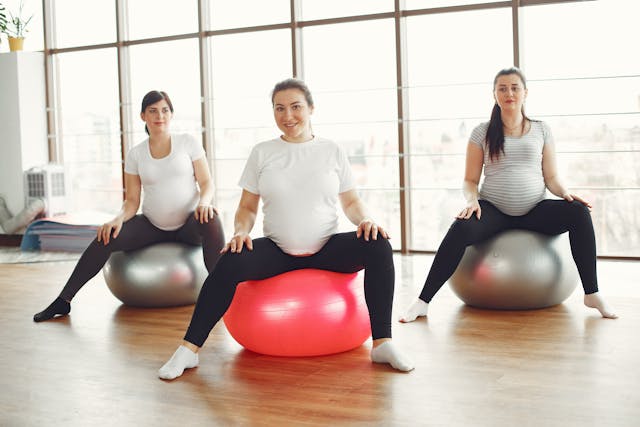Prenatal yoga is an excellent way for expectant mothers to maintain their health, reduce stress, and prepare their bodies for childbirth. Incorporating specific yoga stretches into your routine can help alleviate common pregnancy discomforts and enhance overall well-being. Here, we’ll explore some of the best prenatal yoga stretches, their benefits, and tips for practising them safely.
Benefits of Prenatal Yoga
Prenatal yoga offers numerous benefits that make it a valuable addition to any pregnancy routine. These benefits include:
- Improved Flexibility and Strength: Prenatal yoga helps maintain muscle tone and flexibility, supporting the additional pregnancy weight and preparing the body for labour.
- Reduced Back Pain: Many yoga stretches focus on the lower back and hips, helping to alleviate pain and discomfort in these areas.
- Better Posture: As the body changes, maintaining good posture becomes challenging. Yoga can help strengthen the core and improve posture, reducing strain on the back and shoulders.
- Enhanced Relaxation and Stress Reduction: Yoga’s breathing exercises and mindful movements promote relaxation and can reduce stress and anxiety.
- Improved Circulation: Yoga promotes better blood flow, which can help reduce swelling in the feet and legs.
Safe Prenatal Yoga Stretches
When practising prenatal yoga, it’s essential to focus on stretches that are safe and specifically designed for pregnancy. Liven up your routine with these top-notch stretches:
- Cat-Cow Stretch (Marjaryasana-Bitilasana)
This gentle flow between two poses helps to relieve tension in the spine and improve flexibility in the back and neck.
- How to do it: Get ready to move! Begin in a tabletop position, starting on your hands and knees. As you inhale, arch your back and lift your head and tailbone towards the sky (Cow Pose). Remember to round your spine, tuck your chin, and tuck your tailbone as you exhale (Cat Pose). Repeat this flow for several breaths.
- Child’s Pose (Balasana)
Child’s Pose is a restful pose that gently stretches the hips, thighs, and back.
- How to do it: Get down on the floor with your big toes touching and your knees spread apart. Sit back on your heels, extend your arms forward, and lower your forehead to the mat. Take deep breaths and relax in this pose.
- Seated Forward Bend (Paschimottanasana)
This stretch helps to elongate the spine and gently stretches the hamstrings.
- How to do it: Sit with your legs extended straight in front of you. Flex your feet and hinge at your hips to fold forward, reaching towards your toes. Maintain a long, strong spine and avoid hunching your back. Use a strap around your feet if you can’t reach your toes.
- Bound Angle Pose (Baddha Konasana)
This pose opens the hips and groin, which can benefit childbirth.
- How to do it: Sit with your legs straight in front of you, then bend your knees and bring the soles of your feet together. Allow your knees to drop to the sides, and hold your feet with your hands. Sit up tall and gently press your knees towards the floor.
- Pigeon Pose (Eka Pada Rajakapotasana)
Pigeon Pose is excellent for opening the hips and relieving lower back pain.
- How to do it: Get ready to begin in a tabletop position. Bring your right knee forward towards your right hand and extend your left leg straight back behind you. Lower your hips to the floor and keep your back leg straight. Hold this pose and breathe deeply before switching sides.
Tips for Practicing Prenatal Yoga Safely
To ensure a safe and beneficial prenatal yoga practice, keep these tips in mind:
- Consult Your Healthcare Provider: Before starting any new exercise routine, including prenatal yoga, consult your healthcare provider to ensure it’s safe for you and your baby.
- Choose the Right Classes: Look for prenatal yoga classes or instructors who are certified in prenatal yoga. They will be knowledgeable about the modifications needed for pregnant women.
- Listen to Your Body: Tune into how your body feels as you go through each stretch. Avoid any poses that feel uncomfortable or cause strain. Remember, it’s essential to be gentle with yourself during pregnancy.
- Avoid Deep Twists and Inversions: Deep twists and inversions can compress the abdomen and are generally not recommended during pregnancy. Focus on open twists and supported poses instead.
- Stay Hydrated: Remember to stay hydrated by drinking plenty of water before, during, and after your yoga session. Staying hydrated is crucial for a great practice and overall well-being.
Conclusion
Prenatal yoga stretches can be a wonderful addition to a healthy pregnancy routine, offering physical and emotional benefits that help expectant mothers navigate the challenges of pregnancy. Pregnant women can enjoy the calming and strengthening effects of yoga by incorporating safe and gentle stretches, consulting with healthcare providers, and choosing qualified instructors. Remember, each pregnancy is unique, so it’s essential to listen to your body and seek professional advice to ensure the best care for you and your baby.











